ASDWA collects data, conducts analysis, and provides policy recommendations to educate decision-makers on the states’ perspective on drinking water issues that impact its members.
Hidden Consequences: How Congressionally Directed Spending Impacts State Drinking Water Programs (12/2023)
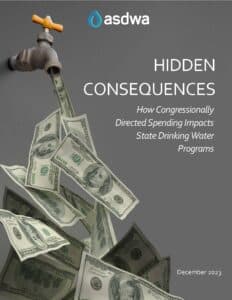
In fiscal year 2022, the ban on Congressionally Directed Spending (CDS) was lifted, allowing Congressional members to use the Drinking Water State Revolving Funds (DWSRF) to fund community projects. Funding for CDS projects is taken from the DWSRF capitalization grants that go to the states and are then dispersed directly to communities as grants. Redirecting funds from the DWSRF significantly reduces the overall funding available to states’ drinking water programs that ensure public water systems (PWS) meet regulatory standards, provide technical assistance to improve PWS compliance, and increase public health protection.
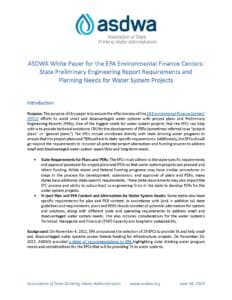
ASDWA worked with its Small Systems Committee to develop this paper. The purpose of the paper is to ensure the effectiveness of the 29 EPA Environmental Finance Centers’ (EFCs’) efforts to assist small and disadvantaged water systems with project plans and Preliminary Engineering Reports (PERs). The paper provides an overview of the state PER requirements and water system project planning needs, and shares examples from different states.
ASDWA – A New Era for the Drinking Water State Revolving Funds (1/2023)
The Bipartisan Infrastructure Law (BIL) has specific requirements for state programs distributing funds, including a 49% subsidy requirement in the form of grants, principal forgiveness, or negative interest rate loans for communities deemed disadvantaged. The SDWA leaves defining what constitutes a “disadvantaged community” (DAC) up to the state DWSRF programs. This white paper includes an analysis of the changes made by states to their DAC definitions after the passage of BIL. It also includes 10 case studies of DWSRF programs that modified either their DAC definitions or their affordability criteria to better meet the needs of their communities. ASDWA intends for state staff to use this document as they work to analyze the viability of their current DAC definitions and affordability criteria, modify these parameters, or continue to evaluate their new definitions.
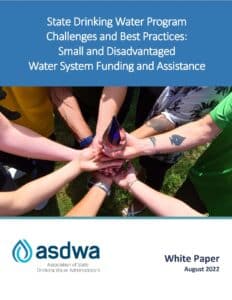
ASDWA Small and Disadvantaged Water System Funding and Assistance White Paper (8/2022)
ASDWA worked with the Southwest Environmental Finance Center and the ASDWA DWSRF and Small Systems Committees, and Justice40 Workgroup to develop this paper. It provides information about state and water system challenges and explores a variety of state efforts and activities to fund and assist their small and disadvantaged water systems, along with specific state examples.
ASDWA Lead Service Line Inventory Framework (2/2022)
ASDWA worked with the Lead Service Line Inventory Workgroup to develop the State Implementation Framework for Lead Inventory Requirements under EPA’s Lead and Copper Rule Revisions (LCRR) and Template for CWS and NTNC Systems. The purpose of this framework and template is to provide useful and consistent information to primacy agencies, water systems, and consultants to start the development of lead service line inventories while EPA develops inventory guidance. The intent of this framework is to serve as a prequel for EPA’s Inventory Guidance and to ensure that everyone is working off the same information when starting inventories. The inventory template is intended to be used by states and water systems as a starting point for inventory development and data collection.
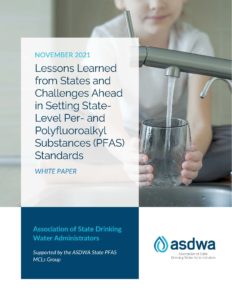
ASDWA PFAS MCLs White Paper (11/2021)
ASDWA worked with 15 states to develop this White Paper entitled, “Lessons Learned from States and Challenges Ahead in Setting State-Level Per- and Polyfluoroalkyl Substances (PFAS) Standards.” The White Paper provides an overview of current state PFAS efforts and seven topic sections on the key components of the regulatory setting process for states that are developing or considering developing PFAS drinking water Maximum Contaminant Level (MCL) regulatory standards or guidelines, or want to take other actions to assess and address PFAS.
ASDWA partnered with the Ground Water Protection Council (GWPC) to develop this report that continues our collective efforts to share information about the accomplishments of state source water protection (SWP) programs in coordination with the USDA Natural Resources Conservation Service (NRCS), state foresters, the US Forest Service (USFS) and other partners, as well as challenges and tips for success with state examples of potential solutions for making further progress.
ASTHO partnered with ASDWA to develop this communications factsheet to provide information that state health agency and state environment agency staff can use when talking to building and facility personnel about Legionella and other opportunistic biofilm pathogens, provide information to increase building owner awareness of the potential for pathogens to grow in building water systems, including resources that can help them reduce or minimize pathogen growth in their plumbing, and outline proactive Legionella-related communications methods for state agencies to consider.
Substantial uncertainty still surrounds the nation’s water systems regarding the number and locations of lead service lines (LSLs). This uncertainty stems primarily from inadequate records and data. The accuracy of these records carries significant implications for utility operations, public health, regulatory compliance, and long-term asset management. BlueConduit, in partnership with ASDWA, developed this white paper to outline important considerations for state regulators and utility leadership when using statistical and predictive methods for LSL inventory and replacement.
In May 2020, the Association of State Drinking Water Administrators (ASDWA) Regulatory Committee conducted a comprehensive survey on distribution systems with its members to determine what distribution system issues are most commonly faced by state water programs, gather management practices and policies to share amongst the states, and collect additional information that could be used to inform future regulations. The survey was completed by drinking water program representatives from 41 states and territories. This white paper summarizes the results of the survey.
This factsheet, jointly developed with the Association of State and Territorial Health Officials (ASTHO) in partnership with ASDWA, and outlines how to monitor water quality in facilities to prevent the growth of Legionella and other opportunistic pathogens. It discusses important basic water quality monitoring parameters, including temperature, pH, turbidity, and disinfectant residual. The document is meant to help water management program teams understand the water quality at the building point of entry so they can establish the water quality baseline for the building.
ASDWA developed this guide and toolkit with support from a Project Advisory Council (PAC) with representatives from nine states (Colorado, Kansas, Minnesota, New Hampshire, North Carolina, Pennsylvania, Vermont, Virginia, and Wisconsin), and the Cadmus Group. The purpose of the guide is to demonstrate and share effective strategies for addressing PFAS contamination risk in source waters that will help inform policy decisions, assist state drinking water programs in protecting public health, and encourage collaboration and communication among states and water utilities.
ASDWA worked with a team of state drinking water administrators to develop this toolkit for state drinking water agencies. The toolkit is intended to help these agencies move from a strong signal of potential risk from a CEC in drinking water to managing risk to an acceptable level, potentially including creating a state-specific CEC rule establishing a Maximum Contaminant Level (MCL) or treatment technique. The toolkit draws heavily on participating states’ recent experience managing risks from Per- and Polyfluoroalkyl Substances (PFAS) but generalizes from this experience to be broadly applicable to other CECs.
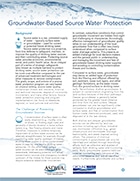 Groundwater-Based Source Water Protection (9/2019)
Groundwater-Based Source Water Protection (9/2019)ASDWA and the Ground Water Protection Council (GWPC) jointly released this paper developed by ASDWA as an educational handout for state water programs, water utilities, and stakeholders to talk about the importance of protecting groundwater sources of drinking water. Anyone interested in protecting groundwater can use this paper to help drive actions and work with partners on any or all the considerations, authorities, approaches, and examples that the paper provides.
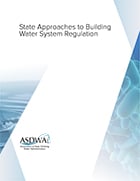 State Approaches to Building Water System Regulation (2019)
State Approaches to Building Water System Regulation (2019)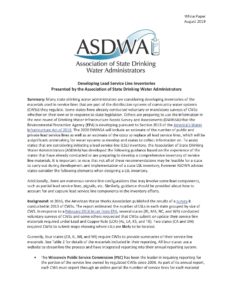 Developing Lead Service Line Inventories (8/2019)
Developing Lead Service Line Inventories (8/2019)Many state drinking water programs are considering developing inventories of the materials used in service lines that are part of the distribution system of the community water systems (CWSs) they regulate. Some states have already conducted voluntary or mandatory surveys of CWSs whether on their own or in response to state legislation. Others are preparing to use the information in the next round of Drinking Water Infrastructure Needs Survey and Assessments (DWINSA) that EPA is developing pursuant to Section 2015 of the America’s Water Infrastructure Act of 2018 (AWIA). To assist states that are considering initiating a lead service line (LSL) inventory, the Association of State Drinking Water Administrators (ASDWA) has developed the following guidance based on the experience of the states that have already conducted or are preparing to develop a comprehensive inventory of service line materials.
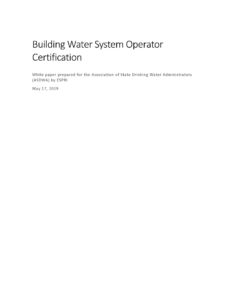 Building Water System Operator Certification (5/2019)
Building Water System Operator Certification (5/2019)When a building installs water treatment they may then be considered a public water system under the Safe Drinking Water Act (SDWA) and subject to the SDWA requirements including sampling for regulated contaminants and having a certified operator for the facility. Persons qualified to run a building water system require specific knowledge, skills, and abilities that, in some cases, are different from the knowledge required for a traditional water system operator. The paper makes recommendations on what those key knowledge sets are. The paper does not explore what constitutes treatment or the different ways states are approaching regulating building water systems.
State drinking water programs have been chronically underfunded, and the workloads have increased dramatically over the past nine years primarily due to emerging contaminants. The updated report on states’ resources and needs shows that the increasing funding gap increases the potential for public health protection to be compromised.
The public is turning to states for answers and actions when emerging contaminants are detected with potential human health and ecological effects. This report was a partnership between ASDWA and the Association of Clean Water Administrators (ACWA) and provides an assessment and several recommendations for states, federal agencies, and chemical manufactures and producers to better detect, characterize and manage contaminants of emerging concerns.
EPA is evaluating several options for potential Long-Term Revisions to the Lead and Copper Rule (LT-LCR). EPA presented several options at a Federalism Consultation briefing on January 8, 2018, and requested comments by March 8, 2018. ASDWA conducted this Costs of States’ Transactions Study (CoSTS) as part of its comment development process for these regulatory options. The detailed spreadsheets included in this study calculate the estimated hours for the five categories of regulatory options presented at the January 8th meeting, plus an additional category for “Regulatory Start-Up”.
This new report updates the 2013 State Drinking Water Resource Needs Report to estimate the additional resource demands in 2018 from non-regulatory activities such as post-Flint LCR, PFAS, algal toxins, and SDWIS Prime. The increased workload is significant, ranging from 1.1% to 12.5% without calculating the impacts of inflation (an additional 20%) over the past decade. This analysis shows the growing demands on state drinking water programs and highlights the need for either additional funding or a reallocation of resources.
As the public health risks posed by drinking water contaminants and other constituents of concern become more complex and pressing, state program responsibilities for adequately managing sources of drinking water, overseeing the treatment of drinking water, and supervising water systems all increase. In 2013, ASDWA produced this report to intertwine the public health protection mission and responsibilities of state drinking water programs with a funding needs assessment and analysis of outcomes should inadequate funding be provided.

2021 © All Rights Reserved. Privacy Policy.
